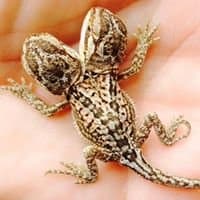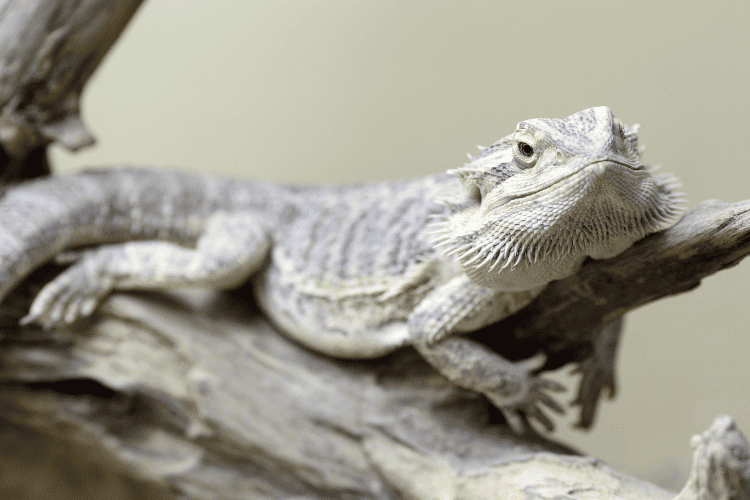
Bearded dragons, scientifically referred to as Pogona vitticeps, are a popular reptile pet choice because of their friendly demeanor, intriguing behaviors, and unique appearance.
In this complete guide, we will delve into the world of bearded dragons, exploring their natural habitat, ideal captive environment, dietary needs, handling and temperament, common health issues, and more.
Whether you’re a seasoned reptile keeper or new to the world of reptiles, this guide will equip you with the knowledge necessary to provide the best care for your lovely bearded dragon.
How Do Bearded Dragons Look?
Bearded dragons are diurnal lizards that belong to the Agamidae family. They’re native to the arid regions of Australia, specifically found in the wild across a wide range, including parts of South Australia and Western Australia.
The scientific name, Pogona vitticeps, is derived from the spiny scales around their throat that can puff up when threatened, resembling a “beard.”
These fascinating creatures are known for their docile nature and have become popular as pet reptiles due to their friendly temperament and striking appearance.
One of their most prominent features is their “beard,” which is a flap of skin under their throat that can change color, ranging from pale yellow to dark black.
This display is often associated with certain behaviors, such as dominance, submission, or even during courtship rituals.
Bearded dragons come in a wide variety of colors, including shades of brown, orange, red, and yellow, allowing them to blend in with their natural surroundings.
They are also equipped with spiny scales along their sides and back, providing some protection against predators.
Bearded dragons are known for their territorial and cheeky behavior, especially among adult males. During the breeding season, male bearded dragons may exhibit aggressive behavior towards each other, emphasizing the importance of providing adequate space and a stress-free environment.
What are Bearded Dragon Morphs?
In the wild, beardies have a camouflaged mottled appearance to fit in with their rocky and sandy environment. However, in captivity they can be bred to show all sorts of amazing colors. These colors are called morphs. Some of the most sought-after morphs can sell for thousands of dollars!
Check out this guide to bearded dragon morphs for more info. Below are some of the major morphs, click into each one to see more information about how they are bred and their characteristics.
- Standard or wild bearded dragon Morph: This is the most common type, often seen in the wild. They typically have a brown or tan coloration.
- Leatherback bearded dragon Morph: Characterized by a smoother back with smaller scales, reducing the spikiness seen in standard morphs. Their color can vary widely.
- Silky bearded dragon Morph: Similar to the leatherback, but with even smaller scales, giving them a silkier appearance. Their coloration can be quite varied.
- Hypomelanistic bearded dragon Morph: These bearded dragons have less melanin, resulting in lighter coloration. They often appear in shades of orange, yellow, or pale tan.
- Translucent bearded dragon Morph: Recognized by their semi-transparent scales, especially noticeable when they are young. They often have a bluish tint to their belly and a light coloration overall.
- Red bearded dragon Morph: These dragons are bred for their deep red coloration, which can range from a bright, fiery red to a darker, brick red.
- Yellow bearded dragon Morph: As the name suggests, these dragons exhibit various shades of yellow.
- White bearded dragon Morph: They have a predominantly white coloration, though they might have some patches of other colors.
- Zero and Wero bearded dragon Morph: These are completely patternless and have a pale, almost ghost-like appearance.
- Witblits bearded dragon Morph: They are patternless and come in various shades of beige, peach, or even pink.
- German Giant bearded dragon Morph: Larger than the standard morph, this variety is bred for its size rather than color, which can vary.
- Dunner bearded dragon Morph: Named after the breeder who developed it, the Dunner morph is characterized by a unique scale pattern that runs in multiple directions, unlike the uniform pattern of standard dragons.
- Paradox bearded dragon Morph: This morph is known for its irregular color patches and spots, which can appear in various colors and are not symmetrical or patterned.
- Hypo Translucent bearded dragon Morph: A combination of the Hypomelanistic and Translucent traits, these dragons have less melanin and semi-transparent scales, resulting in unique coloration and texture.
Ask the Expert
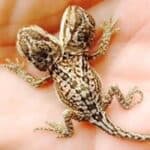
What is the most expensive bearded dragon morph?
Is the care the same for all bearded dragon morphs?
Stephen Evans is a Bearded Dragon Breeder, and owner of dragonmorphs.co.uk. You can follow him on Facebook.
Where Do Bearded Dragons Live?
In the wild, bearded dragons thrive in a variety of environments, from deserts to woodlands and shrublands. They’re well-adapted to the harsh conditions of their natural habitat, which typically experiences high temperatures and low humidity levels.
The temperature in their native range can vary significantly, with daytime temperatures often reaching extremes of up to 95°F (35°C) or more during the hotter months.
However, bearded dragons are also equipped to tolerate cooler temperatures at night, which can drop to around 65°F (18°C) or lower.
Humidity levels in their natural environment are generally low due to the arid climate.
Bearded dragons have evolved to the point that they’re efficient in conserving water and can go for extended periods without drinking, obtaining much of their hydration from their diet of plant matter and insects.
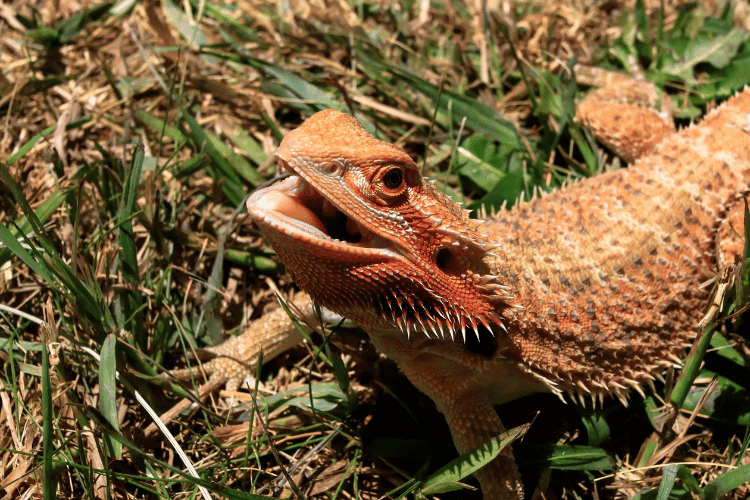
The terrain in their native range consists of rocky outcrops, sand dunes, and arid grasslands, providing ample opportunities for basking, climbing, and digging.
These reptiles are skilled climbers and are often seen perched on rocks or fence posts, soaking up the sun's warmth.
Providing a suitable habitat for pet bearded dragons should mimic their natural environment. This can be achieved through the use of heat lamps and basking spots to create a temperature gradient, as well as providing a basking platform and climbing opportunities.
Maintaining the appropriate temperature and humidity levels in captivity is crucial for their health and well-being.
What Is the Ideal Captive Habitat for Bearded Dragons?
The ideal captive habitat for bearded dragons should prioritize their comfort, health, and natural behaviors.
A spacious enclosure is essential, providing enough room for them to move around and explore. A minimum enclosure size of around 40-50 gallons is advised for young dragons, whereas adult dragons require at least a 75-gallon tank or larger.
The bearded dragon’s enclosure should be equipped with proper lighting and heating to create a suitable temperature gradient.
One side of the enclosure should have a basking area with a basking lamp or ceramic heat emitter, maintaining a temperature of around 95°F (35°C) to allow for proper digestion and thermoregulation.
The other side of the enclosure should be cooler, with temperatures ranging from 75°F to 85°F (24°C to 29°C).
Full-spectrum UVB lighting is crucial for bearded dragons to synthesize vitamin D3 and absorb
For substrate, options such as reptile carpets, ceramic tiles, or non-adhesive shelf liners are a lot preferable over loose substrates, which can pose ingestion risks.
Providing rocks, branches, and ledges for climbing mimics their natural behavior and helps keep them mentally stimulated. Hiding spots, such as half logs or reptile caves, give bearded dragons a sense of security.
It's crucial to maintain a clean and hygienic environment for captive bearded dragons. Regular spot-cleaning and thorough cleaning of the enclosure are necessary to prevent the buildup of bacteria and other harmful pathogens.
What Are the Ideal Tank Mates for Bearded Dragons?
Bearded dragons are best kept in solitary setups due to their territorial nature.
Keeping them with other animals, even of the same species, can lead to stress, aggression, and potential injury.
So, it’s recommended to house bearded dragons separately from other animals to ensure their well-being and minimize potential conflicts.
What Are the Feeding Habits of Bearded Dragons?
Bearded dragons are omnivorous reptiles with specific dietary needs. Their diet should consist of a balanced mix of live prey, insects, and plant matter.
A staple of leafy greens, like collard greens, mustard greens, and dandelion greens, provides essential vitamins and minerals.
Young bearded dragons need more animal protein for growth and should be fed a combination of appropriately sized live insects like crickets, dubia roaches, and mealworms.
As they mature, the ratio of plant matter to animal protein should shift towards more greens and fewer insects.
The feeding frequency for juvenile bearded dragons should be around 2-3 times a day, gradually reducing to once a day as they grow older.
Adult dragons can be fed every other day or even every few days, depending on their activity level and overall health.
Proper
Dusting their insect prey with a
You must always provide fresh, clean water in a shallow dish for drinking, but be aware that bearded dragons often get their hydration from the food they eat.
What Is the Temperament of Bearded Dragons?
Bearded dragons are known for their generally docile and friendly nature, making them popular as pets. They tolerate handling well, especially when properly acclimated and treated with care. However, individual temperaments may vary, and some may be more skittish or reserved.
When interacting with a bearded dragon, it's crucial to approach them calmly and gently. Avoid sudden movements or loud noises that might startle them.
Allow the dragon to become familiar with your presence by spending time near their enclosure before attempting to handle them.
When picking up a bearded dragon, support their body with both hands to prevent them from feeling unstable or anxious. Avoid gripping them tightly, as this can cause stress or discomfort. Instead, use a gentle yet secure hold.
While bearded dragons are generally well-suited for handling, it's crucial to recognize that they are still wild animals at heart.
Avoid excessive handling, especially during times of stress, such as after relocation or illness. Over-handling can lead to undue stress, affecting their well-being.
Additionally, be mindful of the temperature of your hands when handling bearded dragons, as extreme heat or cold can cause distress. Wash your hands before and after handling to avoid transmitting potentially harmful bacteria to or from the reptile.
Young bearded dragons may be more skittish than adults, so patience and gentle handling are especially important during their early stages of development.
What Are the Common Health Issues for Bearded Dragons?
Bearded dragons are hardy reptiles, but they can still face some common health concerns. It's essential for pet owners to be vigilant and watch for any signs of illness.
Some common health issues in bearded dragons include:
- Metabolic Bone Disease (MBD): Caused by
calcium and vitamin D deficiency, MBD can lead to weak bones, deformities, and even fractures. Providing a balanced diet with propercalcium supplementation is crucial for prevention. - Intestinal Parasites: Bearded dragons can sometimes be affected by internal parasites, which can lead to digestive issues and weight loss. Regular fecal examinations and a sanitary habitat help prevent parasite infections.
- Respiratory Infections: Incorrect temperatures and humidity levels can cause respiratory problems. Signs of a respiratory infection include wheezing, nasal discharge, and labored breathing.
- Impaction: Ingestion of indigestible materials, such as loose substrate, can lead to impaction. Ensuring a suitable substrate and proper feeding practices can prevent this issue.
- Tail Rot: Poor husbandry or injuries can lead to tail rot, a condition where the tail becomes necrotic. Maintaining a clean and hygienic environment helps prevent tail rot.
What Are the Lifespan and Size of Bearded Dragons?
Bearded dragons have an average lifespan of 8 to 12 years in captivity, though with proper care, some individuals can live even longer.
As they progress through their life stages, bearded dragons undergo major growth. At hatching, they are tiny, measuring around 3 to 4 inches in length. As juveniles, they can reach lengths of 12 to 16 inches within their first year.
As they mature into adulthood, bearded dragons can grow to an average length of 18 to 24 inches (45 to 60 centimeters) from head to tail. Males typically have larger bodies and heads compared to females, but both sexes can reach similar lengths.
It's important for bearded dragon owners to consider their long lifespan and potential size when providing them with an appropriate habitat and committing to their care.
What Are the Breeding Habits of Bearded Dragons
Bearded dragons, like many reptiles, engage in sexual reproduction. Breeding behavior is more commonly observed in adult dragons, typically reaching sexual maturity at 1 to 2 years old.
During the breeding season, which is typically in the spring, male bearded dragons may display dominant behaviors, including head-bobbing, arm-waving, and darkening of their beard. These displays are often directed towards adult females as part of their courtship ritual.
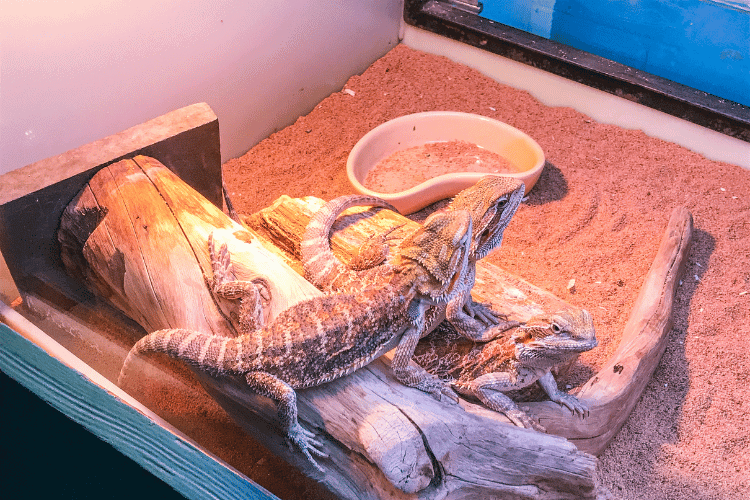
Female bearded dragons lay clutches of eggs, typically burying them in a suitable nesting area within the enclosure. When breeding in captivity, it's essential to provide a nesting box filled with a suitable substrate, such as a mixture of sand and soil, for the female to lay her eggs.
After the female lays the eggs, they can be removed from the box and incubated separately to ensure their safety and proper development.
The incubation temperature is critical for successful hatching, typically ranging from 82°F to 86°F (28°C to 30°C). Eggs usually hatch after an incubation period of around 50 to 70 days.
Are There Legal Considerations for Owning a Bearded Dragon?
Owning bearded dragons as pets may require permits or licenses in some regions. Local laws can restrict their importation or possession to protect native wildlife.
Complying with legal requirements ensures the proper care of these reptiles and preserves their natural habitats.
Researching and adhering to local laws before acquiring a bearded dragon is very important for responsible ownership.
Additional Resources
- Books:
- "The Bearded Dragon Manual" by Philippe de Vosjoli
- "Bearded Dragons: A Complete Guide to Pogona Vitticeps" by Philip Purser
- "Bearded Dragon Care: The Ultimate Guide for Proper Care of Your Pet" by Jeremy Thompson
- Forums:
- BeardedDragonForum.com
- OurReptileForum.com
Case Study
Meet Jasmine the Fashionista Dragon (@jasminethefashionistadragon), a beautiful beardie that loves food so much that she’s always on the lookout for crickets. She loves eating large crickets.
FAQs
What temperature should the basking spot be?
The basking spot temperature should be around 95°F (35°C) to allow for proper digestion and thermoregulation.
How often should I feed my bearded dragon?
Young bearded dragons should be fed 2-3 times a day, while adults can be fed once a day or every other day.
Can I keep multiple bearded dragons together?
It's best to house bearded dragons separately, as they are territorial and can exhibit aggression towards each other when kept together.
Equipment Needed
- Enclosure (tank or
terrarium ) - Heat lamp
- Hiding spots
- UVB lamp
- Thermometer
- Food and water dishes
- Suitable substrate
- Calcium and multivitamin supplements
- Feeding tongs
- Cleaning supplies
- Branches or climbing perches


